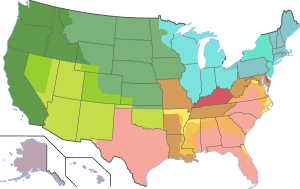Gradual emancipation (United States) facts for kids
Gradual emancipation was a way for some states to end slavery slowly, over many years. Instead of freeing all enslaved people at once, laws were passed that would free them little by little. A famous example is the law passed in Pennsylvania in 1780.
Contents
The Idea of Gradual Emancipation
For a long time, people argued about slavery. In the 1500s, a person named Bartolomé de las Casas said that slavery was wrong. But it was hard to end slavery because it was important for the economy and politics of the time.
Some people wanted to stop the transatlantic slave trade. This was the terrible journey where enslaved people were brought across the Atlantic Ocean. They wanted to stop this cruel trade, but they still thought slavery itself could continue. Other people wanted to end all slavery completely.

Gradual Emancipation in the United States
During the 1700s, new ideas about freedom and human rights became popular. This period was called the Age of Enlightenment. These ideas made more people want to end slavery. In the 1770s, Black people in New England started sending letters to their state governments. They asked for their freedom.
Pennsylvania's Law
Pennsylvania was the first state in the United States to pass a law like this. It was called An Act for the Gradual Abolition of Slavery and was passed in 1780. This law said that:
Every Negro and Mulatto child born within the State after the passing of the Act (1780) would be free upon reaching age twenty-eight."
This meant that children born after 1780 would not be born into lifelong slavery. They would become free when they turned 28 years old. Once they were free, they were supposed to be treated like indentured servants. These were people who worked for a set number of years, usually four, to pay off a debt. They would often receive tools or other benefits when their service ended.
Other Northern States
After Pennsylvania, other northern states also started to end slavery slowly. New Hampshire and Massachusetts did this in 1783. Connecticut and Rhode Island followed in 1784. The Republic of Vermont had already limited slavery in its own rules in 1777. Vermont later joined the United States in 1791.
These states were the first in the Americas to pass laws against slavery. By 1808, it became illegal to bring enslaved people into the country. Even though some people still smuggled them in, the official trade stopped. By the 1820s, all northern states had laws to end slavery, either gradually or right away.
The End of Slavery in the US
During the American Civil War, Abraham Lincoln thought about ending slavery gradually. In 1861 and 1862, he suggested changing the Constitution to do this. But he soon realized that slavery needed to end immediately. More and more people in the North supported ending slavery. Also, enslaved people were helping the Confederate side during the war.
This led to the Emancipation Proclamation, which Lincoln announced on January 1, 1863. This order declared that most enslaved people in the Confederate states were free. After the war ended, the Thirteenth Amendment to the United States Constitution was approved. This amendment made slavery illegal everywhere in the United States. All enslaved people were finally freed.

